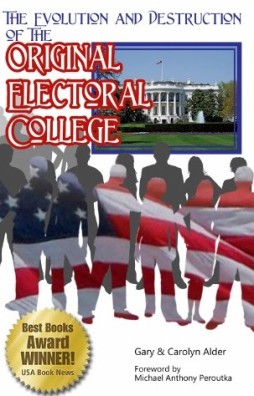Article V – The Amendment Process
The Congress, whenever two thirds of both houses shall deem it necessary, shall propose amendments to this Constitution, or, on the application of the legislatures of two thirds of the several states, shall call a convention for proposing amendments, which, in either case, shall be valid to all intents and purposes, as part of this Constitution, when ratified by the legislatures of three fourths of the several states, or by conventions in three fourths thereof, as the one or the other mode of ratification may be proposed by the Congress; provided that no amendment which may be made prior to the year one thousand eight hundred and eight shall in any manner affect the first* and fourth* clauses in the ninth section of the first article; and that no state, without its consent, shall be deprived of its equal suffrage in the Senate.
-* Article I Section 9 Clause 1
-* Article I Section 9 Clause 4
* * * * * * *
Analysis – Proposing Amendments
Two methods of proposing amendments are described in Article V.
The first method is just an extension of the normal functioning of the legislative branch. They already know how to exercise those powers. They have precept as well as precedent to rely on. Very little additional instruction is needed. To propose an amendment requires the concurrence of a super majority (in this case 2/3) in each house. The reason for the super majority is that when we are contemplating potential changes in the way all laws are made, enforced, or judged, a bare majority is extremely dangerous. We are striving for consensus. In the context provided by the original Constitution, the method of determining consensus outlined here is by requiring the vote of a super majority of two houses that represent different interests, the interest of the people (the House of Representatives) and the interest of the states (the Senate). (Note the effective loss of the representation of different interests resulting from the ratification of the 17th amendment.)
The second method of proposing amendments, while providing a check by the states to an unresponsive congress, has the disadvantage of having neither constitutional instruction for precept as to how a convention would operate nor a reference to an already operating body in order to rely on precedent. In other words there is no set of rules either explicit or implied to be relied upon. All that is stated in Article V is that if 2/3 of the state legislatures call for a convention, Congress must call a convention. It is not stated whether the states will be represented in the convention equally as states or proportionately to each state’s population. There is no requirement listed for any type of super majority vote of the convention to assure consensus of even this one body to propose amendments. This is particularly dangerous in the context of a party system (for which the Constitution has made no provision). If the majority party wanted an amendment and couldn’t get the required super majorities in both houses of Congress all they would need to do is to turn to the states and have them “demand” a convention. In the absence of constitutional or other authoritative direction, a simple majority in both houses of Congress could then determine the rules of any convention so called.
All of the amendments that have been proposed to date were proposed by Congress, so to this point we haven’t had to grapple with the above described situation. In our opinion however, the time to resolve the problems related to the second method of proposing amendments is before the debate on the virtues and vices of a particular proposal tests the fabric of the process. Once a convention is called for, and particularly if it is called to support an amendment dear to the heart of a special interest group, we can all be assured that following correct constitutional procedure will become a non-issue until the amendment is proposed and ratified by any means — legitimate or not.
* * *
Abuses of the Congressional Method of Proposing Amendments
Having shown the weakness of Article V when it comes to the state legislatures demanding that Congress call a constitutional convention, we must refer to the sad experience of historical abuse of the congressional proposal method as well. In our opinion, the Constitution needs to be strengthened in order to prevent occurrences of similar abuse in the future.
In order to propose an amendment by the congressional method a 2/3 super majority is required. This seems quite clear at first appearance. Article V does not explicitly state, however, that this is to be 2/3 of all elected members of each legislative house.
The inherent weakness of the wording of Article V on this point was brought out on December 2, 1803 by Senator Uriah Tracy of Connecticut in his argument opposing passage of the proposal of the 12th Amendment. His words specifically on the subject are:
… “Two-thirds of both Houses,” must, I think, on every fair principle of construction, mean two-thirds of all the members. The number of Senators is thirty-four, two-thirds being twenty-three. And as there is no representation from New Jersey, the number of Representatives is one hundred thirty-six, two-thirds being ninety-one.
My impressions are, sir, that this amendment cannot constitutionally be proposed to the State Legislatures unless it is is agreed to in the two Houses by those numbers twenty-three and ninety-one respectively. …
To view more of the words of Uriah Tracy see .
An even larger view of the *12th Amendment Senate debate is found in Volume V of The Founders’ Constitution.
-* 12th Amendment Senate Debate
In proposing the 14th amendment the process was grossly abused. For details see , an excerpt from Dyett v. Turner, a ruling by the Utah State Supreme Court. The ruling contains an expose by the Utah Justices of the dastardly procedures used by our Congress to foist the 14th Amendment upon the nation.
* * * * * * *
Analysis – Ratification Process
In addition to the two ways to propose amendments, there are also two ways to ratify a proposed constitutional amendment. This is done by either 3/4 of the state legislatures or by conventions of 3/4 of the states. Congress specifies which mode of ratification is to be used when the amendment is proposed.
Sometimes the ratification method is contained within the proposed amendment; at other times the ratification mode as well as parameters relating to a time deadline for ratification although part of the proposing bill remain separate from the actual amendment.
The latter method certainly improves the readability after ratification. While allowing the reader to focus more on the substance of the amendment, doing it this way also allows changes to time limits as well as procedure inasmuch as the procedure is not part of the actual amendment.
* * *
Abuses of the Amendment Ratification Process
In our reference to the abuses in Congress relating to proposing the 14th Amendment we don’t mean to say that the means used to propose the amendment was the extent of the evil perpetrated. When ratifying the 14th Amendment, Dyett v. Turner, the same document previously mentioned shows even more abuse in the ratification process. See for those details.
When we allow a total disregard for the proper constitutional process to take place in the passage of a single amendment we might think that this will only pertain to that amendment’s passage. We might therefore say that in this case the end justifies the means. But let us look a little closer at the power of precedent (often used to justify the exception rather than reinforce the rule). The following link to an argument from ERA Amendment advocates themselves demonstrates our point. The argument invoking the methods employed in ratifying the 14th Amendment is found in the section labeled Rescission at *www.equalrightsamendment.org/viability.htm.
-* www.equalrightsamendment.org/viability.htm
This link displays its own evidence of how tactics that we have labeled as gross abuse are being currently used as precedent to justify the desire of a particular group to reach their own ends. We read from Alexander Hamilton in Federalist #78 the following:
The interpretation of the laws is the proper and peculiar province of the courts. A constitution is, in fact, and must be regarded by the judges, as a fundamental law. It therefore belongs to them to ascertain its meaning, as well as the meaning of any particular act proceeding from the legislative body. If there should happen to be an irreconcilable variance between the two, that which has the superior obligation and validity ought, of course, to be preferred; or, in other words, the Constitution ought to be preferred to the statute, the intention of the people to the intention of their agents.
Nor does this conclusion by any means suppose a superiority of the judicial to the legislative power. It only supposes that the power of the people is superior to both; and that where the will of the legislature, declared in its statutes, stands in opposition to that of the people, declared in the Constitution, the judges ought to be governed by the latter rather than the former. They ought to regulate their decisions by the fundamental laws, rather than by those which are not fundamental.
We understand from Federalist #78 that the Constitution is the will of the people and should overrule legislation which is the will of the legislators. With the bent of the courts to replace the actual meaning of the Constitution with their own opinions we can no longer afford for the Constitution to be silent on this matter.
Our question for you is this: “Are the tactics used in the passage of the 14th Amendment and proposed to be duplicated by advocates of the proposed ERA Amendment the WILL of the people or the MANIPULATION of the people by a special interest group?” This statement is not meant to address the merits of the ERA Amendment, only to demonstrate the way that bad tactics are promulgated.
* * *
How to Determine if an Amendment is Properly Ratified
Part of the excerpt from Dyett v. Turner demonstrates another weakness in Article V that needs some attention:
The Constitution of the United States is silent as to who should decide whether a proposed amendment has or has not been passed according to formal provisions of Article V of the Constitution.
Although the Utah State Supreme Court suggests that the US Supreme Court should decide, our opinion differs–we think that this is something that is best resolved by constitutional amendment to be done without the particular emotion that would accompany any specific issue.
Dr. W. Cleon Skousen in his book The 5000 Year Leap states in his 13th principle “A constitution should be structured to permanently protect the people from the human frailties of their rulers.” In order to protect the people the Constitution must first be able to protect itself from this type of abuse both in the proposal and the ratification of amendment processes.


